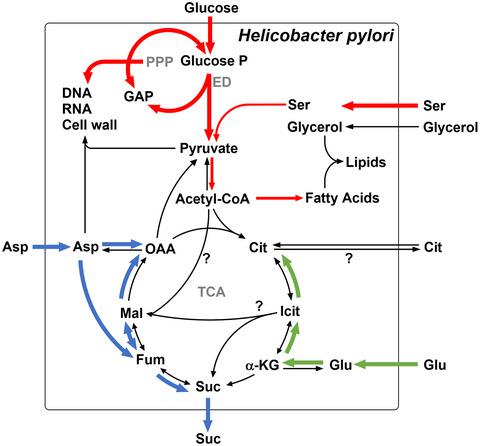当前位置:
X-MOL 学术
›
Mol. Microbiol.
›
论文详情
Our official English website, www.x-mol.net, welcomes your
feedback! (Note: you will need to create a separate account there.)
Substrate usage determines carbon flux via the citrate cycle in Helicobacter pylori
Molecular Microbiology ( IF 2.6 ) Pub Date : 2021-06-23 , DOI: 10.1111/mmi.14775 Thomas M Steiner 1 , Clara Lettl 2, 3 , Franziska Schindele 2 , Werner Goebel 2 , Rainer Haas 2, 3 , Wolfgang Fischer 2, 3 , Wolfgang Eisenreich 1
Molecular Microbiology ( IF 2.6 ) Pub Date : 2021-06-23 , DOI: 10.1111/mmi.14775 Thomas M Steiner 1 , Clara Lettl 2, 3 , Franziska Schindele 2 , Werner Goebel 2 , Rainer Haas 2, 3 , Wolfgang Fischer 2, 3 , Wolfgang Eisenreich 1
Affiliation

|
Helicobacter pylori displays a worldwide infection rate of about 50%. The Gram-negative bacterium is the main reason for gastric cancer and other severe diseases. Despite considerable knowledge about the metabolic inventory of H. pylori, carbon fluxes through the citrate cycle (TCA cycle) remained enigmatic. In this study, different 13C-labeled substrates were supplied as carbon sources to H. pylori during microaerophilic growth in a complex medium. After growth, 13C-excess and 13C-distribution were determined in multiple metabolites using GC–MS analysis. [U-13C6]Glucose was efficiently converted into glyceraldehyde but only less into TCA cycle-related metabolites. In contrast, [U-13C5]glutamate, [U-13C4]succinate, and [U-13C4]aspartate were incorporated at high levels into intermediates of the TCA cycle. The comparative analysis of the 13C-distributions indicated an adaptive TCA cycle fully operating in the closed oxidative direction with rapid equilibrium fluxes between oxaloacetate—succinate and α-ketoglutarate—citrate. 13C-Profiles of the four-carbon intermediates in the TCA cycle, especially of malate, together with the observation of an isocitrate lyase activity by in vitro assays, suggested carbon fluxes via a glyoxylate bypass. In conjunction with the lack of enzymes for anaplerotic CO2 fixation, the glyoxylate bypass could be relevant to fill up the TCA cycle with carbon atoms derived from acetyl-CoA.
中文翻译:

底物使用通过幽门螺杆菌中的柠檬酸循环决定碳通量
幽门螺杆菌在全球范围内的感染率约为 50%。革兰氏阴性菌是胃癌和其他严重疾病的主要原因。尽管对幽门螺杆菌的代谢库存有相当多的了解,但通过柠檬酸循环(TCA 循环)的碳通量仍然是个谜。在这项研究中,不同的13 C 标记的底物在复杂培养基中的微需氧生长过程中作为碳源提供给幽门螺杆菌。生长后,使用 GC-MS 分析在多种代谢物中测定13 C-过量和13 C-分布。[U- 13 C 6] 葡萄糖被有效地转化为甘油醛,但很少转化为 TCA 循环相关的代谢物。相反,[U- 13 C 5 ]谷氨酸、[U- 13 C 4 ]琥珀酸和[U- 13 C 4 ]天冬氨酸以高水平掺入到TCA循环的中间体中。对13 C-分布的比较分析表明,自适应 TCA 循环完全在封闭的氧化方向上运行,草酰乙酸 - 琥珀酸和 α-酮戊二酸 - 柠檬酸之间的快速平衡通量。13TCA 循环中四碳中间体的碳谱,尤其是苹果酸,以及通过体外试验观察到的异柠檬酸裂合酶活性,表明通过乙醛酸旁路的碳通量。结合缺乏用于回补CO 2固定的酶,乙醛酸旁路可能与用源自乙酰辅酶A的碳原子填充TCA循环有关。
更新日期:2021-06-23
中文翻译:

底物使用通过幽门螺杆菌中的柠檬酸循环决定碳通量
幽门螺杆菌在全球范围内的感染率约为 50%。革兰氏阴性菌是胃癌和其他严重疾病的主要原因。尽管对幽门螺杆菌的代谢库存有相当多的了解,但通过柠檬酸循环(TCA 循环)的碳通量仍然是个谜。在这项研究中,不同的13 C 标记的底物在复杂培养基中的微需氧生长过程中作为碳源提供给幽门螺杆菌。生长后,使用 GC-MS 分析在多种代谢物中测定13 C-过量和13 C-分布。[U- 13 C 6] 葡萄糖被有效地转化为甘油醛,但很少转化为 TCA 循环相关的代谢物。相反,[U- 13 C 5 ]谷氨酸、[U- 13 C 4 ]琥珀酸和[U- 13 C 4 ]天冬氨酸以高水平掺入到TCA循环的中间体中。对13 C-分布的比较分析表明,自适应 TCA 循环完全在封闭的氧化方向上运行,草酰乙酸 - 琥珀酸和 α-酮戊二酸 - 柠檬酸之间的快速平衡通量。13TCA 循环中四碳中间体的碳谱,尤其是苹果酸,以及通过体外试验观察到的异柠檬酸裂合酶活性,表明通过乙醛酸旁路的碳通量。结合缺乏用于回补CO 2固定的酶,乙醛酸旁路可能与用源自乙酰辅酶A的碳原子填充TCA循环有关。











































 京公网安备 11010802027423号
京公网安备 11010802027423号